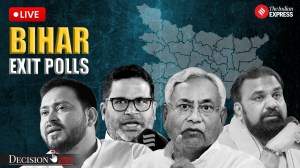Five reasons why the Survey says the Budget has room for fiscal stimulus
Maintaining that higher capital expenditure has been the central to the current year’s budget and economic recovery, the Survey categorically states that above estimated tax collections provide cushion to support growth next year.
 Union Finance Minister Nirmala Sitharaman during a press conference at National Media Centre, in New Delhi, Tuesday, Jan. 18, 2022. (PTI Photo/Vijay Verma)
Union Finance Minister Nirmala Sitharaman during a press conference at National Media Centre, in New Delhi, Tuesday, Jan. 18, 2022. (PTI Photo/Vijay Verma)A day ahead of the Budget, the Economic Survey 2021-22 said that buoyant tax revenues and government policies have created “headroom for taking up additional fiscal policy interventions.” Stressing the need to continue the focus on capital expenditure, it indicated that the government is on course to achieve a fiscal deficit target of 6.8 per cent of Gross Domestic Product for the current year.
Maintaining that higher capital expenditure has been the central to the current year’s budget and economic recovery, the Survey categorically states that above estimated tax collections provide cushion to support growth next year. The policy document also argues that the banking sector is well placed to support the economy as it is now “well capitalized and the overhang of Non- Performing Assets seems to have structurally declined.”
Here are the key takeaways from the Survey regarding progress and direction of fiscal policy:
1. It may be seen that the agile fiscal policy approach adopted by the government, coupled with the buoyant revenue collection received so far this year, has created headroom for taking up additional fiscal policy interventions based on the need of the evolving situation. The targeted focus on capital expenditure, with its resulting multiplier effects, will be vital in sustaining the economic growth.
2. As the economy grows further, the revenue collection from all the sources is expected to be more robust, which will help to strengthen the fiscal position on one hand, and create fiscal space on the other. Thus, it is expected that reaching the budget estimate for fiscal deficit during 2021-22 will not be a concern for the Central Government. A robust economic growth path and various tax policy and administration reforms undertaken over the last few years will be fundamental in sustaining the buoyant revenues in the medium term, and thus, be on track with the fiscal path outlined by the Medium-Term Fiscal Policy Statement.
3. The fiscal support given to the economy as well as the health response caused the fiscal deficit and government debt to rise in 2020-21. However, there has been a strong rebound in government revenues in 2021-22 so far. The revenue receipts of the central government during April- November 2021 have gone up by 67.2 per cent (YoY), as against an estimated growth of 9.6 per cent in the 2021-22 Budget Estimates. The tax collections have been buoyant for both direct and indirect taxes.
4. The fiscal deficit for April-November 2021 has been contained at 46.2 per cent of Budget Estimates (BE) which is nearly one third of the proportion reached during the same period of the previous two years — 135.1% of BE in April-November 2020 and 114.8% of BE in April-November 2019.
5. High tax collections, along with the non-tax revenue boosted by RBI’s surplus transfer to the Government, have contributed to the increase in the revenue pool. The gross tax revenue during this period has registered a growth of over 50 per cent in YoY terms. The gross monthly GST collections have crossed the ` 1 lakh crore mark consistently since July 2021, after quickly recovering from a dip in June 2021 following the second wave of Covid-19.
The Survey said higher capital expenditure has been the central to the current year’s budget and economic recovery. “The expenditure policy of the central government during 2021-22 has a strong emphasis on capital expenditure. The Budget 2021-22 had not only enhanced the expenditure estimates but also directed them towards more productive capital expenditure. During April to November 2021, capital expenditure registered a growth of 13.5 per cent over April to November 2020 and 28 per cent over April to November 2019,” it said.
The Government budgeted for a 34.5 per cent growth in capital expenditure this year over 2020-21 budget estimates – with emphasis on railways, roads, urban transport, power, telecom, textiles and affordable housing amid continued focus on the National Infrastructure Pipeline.



- 01
- 02
- 03
- 04
- 05



































